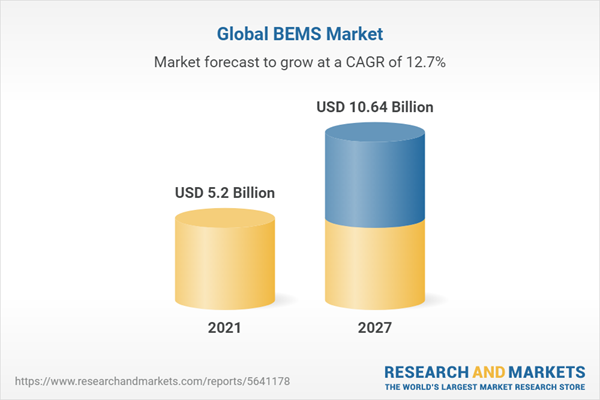The global building energy management system market in 2021 was valued at US$5.20 billion. The market is expected to reach US$10.64 billion by 2027. The building energy management system is a comprehensive system of hardware, software, and services. The system helps to manage energy usage through numerous techniques such as information & communication technology, etc. Moreover, BEMS technology also provides monitoring, automation, and control of building systems such as heating, ventilation & air conditioning, and lighting to escalate the building’s energy efficiency and improve comfort.
Due to the rise in urban population, growth in consumer awareness about the evolvement and use of the latest technology products, and an increase in the number of new construction of buildings, institutes, and complexes, would propel the market growth in the forthcoming years. The market is expected to grow at a CAGR of 12.67% during the forecast period of 2022-2027.
Market Segmentation Analysis:
- By Component: The report provides the bifurcation of the market into three segments based on the component: Services, Software, and Hardware. In 2021, Services held a major share of 47% in the market. On the other hand, the software segment is expected to grow at the highest CAGR in the forthcoming years owing to the rise in technological innovation, increased acceptance of data analytics and cloud technology, and growth in the development of customer-centric models.
- By End-User: The report further provided the segmentation based on the end-user: Residential, Commercial & Institutional, and Industrial. The residential sector held around half of the share in the market. The market's expansion is aided by the rising use of products with high electricity consumption, such as pool heaters, water heaters, batteries & chargers, attic fans, etc.
- By Region: The report provides insight into the building energy management system market based on the regions namely Europe, North America, Asia Pacific, and the Rest of the World. Europe held the major share of above 30% in the market owing to the rising government regulation regarding greenhouse emissions and favorable policies for adopting green building energy management systems.
- In North America, Mexico is expected to be the fastest growing region in the forecasted period. Whereas, in the Asia Pacific region, China held almost 51% share in the market owing to the energy policies of China that emphasize electricity, natural gas, cleaner, high-efficiency, and digital technologies.
Market Dynamics:
- Growth Drivers: One of the most important factors impacting the global building energy management system market is surging energy consumption. The rise in energy consumption led to the increase in electricity production, which directly influenced the production as well as consumption cost. Hence, BEMS being an energy-conservative technology would attract more people to efficiently manage the use of natural resources and reduce the cost burden of electricity prices. Furthermore, the market has been growing over the past few years, due to factors such as rapid urbanization, growth in adoption of smart home products, rise in carbon dioxide emission, accelerating construction activities, rise in consumer spending, growth in consumer awareness, adoption of smart sensors, and many other factors.
- Challenges: However, the market has been confronted with some challenges specifically, high installation costs, lack of trained experts, etc.
- Trends: The market is projected to grow at a fast pace during the forecast period, due to various latest trends such as cloud technology, the surge in adoption of the internet of things (IoT), the decline in fossil fuels, government initiatives and regulations, etc. The infusion of IoT in BEMS and merging it with multiple features such as lighting, security, and heating is facilitating the user to efficiently operate such equipment. Hence, the growth of the IoT market would congruently support the growth of the BEMS market also.
Impact Analysis of COVID-19 and Way Forward:
COVID-19 has negatively impacted the market growth in the year 2020. Industrial and commercial building energy demand has declined significantly in many countries, accompanied by an increase in residential energy demand. Restricting social distancing has resulted in a sharp drop in the utilization of commercial buildings. However, in 2021, the stabilization of the global economy and the clearance of the roadblocks in industrial manufacturing has resulted in tremendous growth in the BEMS market.
Competitive Landscape:
The global building energy management system market is moderately fragmented, with a large number of small- and medium-sized manufacturers accounting for a major revenue share.
The key players in the global building energy management system market are:
- Honeywell International Inc.
- Enel S.p.A (Enel X)
- Johnson Controls International PLC
- ABB Group
- Siemens AG
- General Electric Company (GE)
- Schneider Electric SE
- Emerson Electric Co.
- Azbil Corporation
- Landis+Gyr
- Robert Bosch GmbH
- IBM Corporation
Some of the strategies among key players in the market for building energy management systems are product launches, mergers, acquisitions, and collaborations. For instance, in 2021, Emerson Electric Co. acquired OSI, an operations technology software provider, which broadens and complements Automation Solutions’ software portfolio and ability to help customers in the global power industry. Whereas, Landis+Gyr acquired True Energy A/S, which complements the company’s portfolio by expanding its smart infrastructure.
Table of Contents
1. Executive Summary
Companies Mentioned
- Honeywell International Inc.
- Enel S.p.A (Enel X)
- Johnson Controls International PLC
- ABB Group
- Siemens AG
- General Electric Company (GE)
- Schneider Electric SE
- Emerson Electric Co.
- Azbil Corporation
- Landis+Gyr
- Robert Bosch GmbH
- IBM Corporation
Methodology

LOADING...
Table Information
| Report Attribute | Details |
|---|---|
| No. of Pages | 147 |
| Published | August 2022 |
| Forecast Period | 2021 - 2027 |
| Estimated Market Value ( USD | $ 5.2 Billion |
| Forecasted Market Value ( USD | $ 10.64 Billion |
| Compound Annual Growth Rate | 12.7% |
| Regions Covered | Global |
| No. of Companies Mentioned | 12 |









